Native plants may be the darlings of the plant world, but there are a lot of positive things to say about non-natives.
Just last month the National Arboretum presented an all-day conference – “Native Plants Enriching Our Communities” – with discussions encouraging wider use of native plants because of their social and environmental connections and perceived superior adaptability.
Indeed, some of my gardening friends have become scolds when they notice the extent to which non-natives dominate my borders. They argue that natives are better at attracting birds, butterflies and other wildlife.
However, the truth is that non-native plants are often healthier and happier in our gardens, and wildlife very often choose non-native plants over natives. The reason is that the conditions in our urban and suburban gardens (or anywhere construction has occurred) are very different from wherever the natives originated. The forests are no longer here, water and light cycles have changed, and soil composition is often sullied.
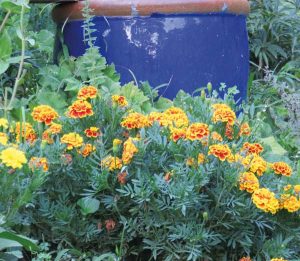 What is important, in fact, is diversity in our plantings. Except for several non-native plants that have become invasive (multiflora rose, honeysuckle, paulownia trees and bittersweet come to mind here in Lancaster County, and thanks to global climate change, kudzu is on the way), there is no coherent reason for insisting on growing only native plants. Generally, when non-natives become troublesome, it is because we have altered conditions in ways that make it difficult for them to thrive. If we are wanting to grow exclusively native plants, we need to undertake the colossal task of restoring soil conditions.
What is important, in fact, is diversity in our plantings. Except for several non-native plants that have become invasive (multiflora rose, honeysuckle, paulownia trees and bittersweet come to mind here in Lancaster County, and thanks to global climate change, kudzu is on the way), there is no coherent reason for insisting on growing only native plants. Generally, when non-natives become troublesome, it is because we have altered conditions in ways that make it difficult for them to thrive. If we are wanting to grow exclusively native plants, we need to undertake the colossal task of restoring soil conditions.
The claim is repeated that native plants are best for pollinating insects (and I have taken this viewpoint in past Gardening Journey columns). However, a recent four-year field study concluded that the best way to support beneficial insects in our gardens is to have a mix of flowers from different countries and regions. The reality is simple: the more flowers in a garden throughout the entire growing season, the more pollinators it will attract. Of course, we cannot disregard growing the native plants that some native butterfly larvae require (also discussed in past GJs).
Obviously, we should grow lots of native plants for all the reasons the “nativists” moralize. But, because of our present-day soil conditions, thoughtful gardeners soon appreciate that plants from other countries with climates similar to ours are often better adapted and do better.
Indeed, it is hard to envision our borders if we excluded the non-natives. What would our springs be like without our Asian witch hazels, middle-eastern tulips, flowering crabapples, peonies, bleeding hearts, azaleas, pieris and magnolias? There would be no tourists converging on the Tidal Basin in Washington, D.C., to see the Yoshino cherries. In the summer: no lilacs, garden roses, daylilies, hostas, astilbes and hydrangeas. The rugosa rose that helps stabilize our seashores is not native. And, into fall: no anemones and chrysanthemums. And, don’t forget the ubiquitous pachysandra. Also, the countless evergreens, including boxwood, Hinoki false cypress, yews and Atlas cedars. And, the glory of any garden: Japanese maples. There are whole nurseries specializing in them.
Many of these plants were brought from their native countries in the second half of the 19th century when plant collectors from Great Britain and our own E. H. Wilson from Harvard’s Arnold Arboretum made their way into eastern Asia. Many early explorers were physicians looking for medicinal plants. And during our time, plant breeders are hybridizing improved garden plants using species from wide-spread geographic areas.
How many plant-derived foods on your dinner table are from natives? Most are not; think of potatoes, tomatoes, apricots, apples, pears, cherries, squash and the current food craze, kale.
And if we expelled Mexican plants from our annual borders, we would have no salvias, Ipomoea (sweet potato vine), bacopa, agastaches, melampodium, chili peppers (Capsicum annuum), cosmos, cuphea (cigar flower), bidens, marigolds, sanvitalia, yuccas, agaves and many sedums.
Several immigrant plants and trees that are favorites in my garden.
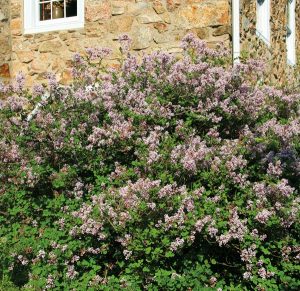 The Korean lilac (Syringa meyeri), a dense, naturally rounded shrub, 4-5 feet high, is a must for every garden. It flowers over a long period during April and May in full sun with showy, very fragrant profuse flowers that attract hummingbirds and butterflies. It is not plagued with the mildew that typically disfigures the foliage of the common lilac for most of the year. It tolerates dry soil and urban conditions. The Korean lilac is also effective massed or used as a hedge or low screen.
The Korean lilac (Syringa meyeri), a dense, naturally rounded shrub, 4-5 feet high, is a must for every garden. It flowers over a long period during April and May in full sun with showy, very fragrant profuse flowers that attract hummingbirds and butterflies. It is not plagued with the mildew that typically disfigures the foliage of the common lilac for most of the year. It tolerates dry soil and urban conditions. The Korean lilac is also effective massed or used as a hedge or low screen.
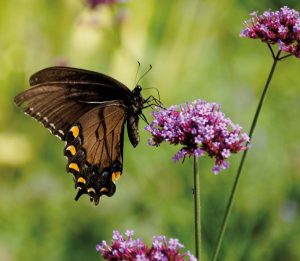 Verbena (Verbena bonariensis), a native of South America, is a reseeding annual for me. It blooms from June to frost with clusters of rose-violet flowers floating above other plants on rigid square 2-foot stems. The planting is a magnet for butterflies. This verbena tolerates poor dry soil and is great in meadows and cottage gardens. Its color harmonizes mixed borders.
Verbena (Verbena bonariensis), a native of South America, is a reseeding annual for me. It blooms from June to frost with clusters of rose-violet flowers floating above other plants on rigid square 2-foot stems. The planting is a magnet for butterflies. This verbena tolerates poor dry soil and is great in meadows and cottage gardens. Its color harmonizes mixed borders.
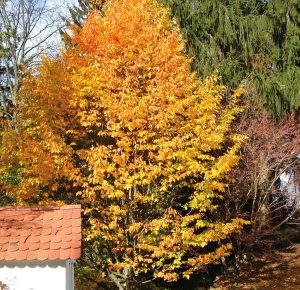 Persian ironwood (Parrotia persica) deserves wider recognition. With its slow growth to 25 feet, it’s a great tree for near the urban patio or as a street tree under power lines. Its wine-red flowers are barely noticeable and appear in late winter like its cousins in the witch hazel family. It originates in Iran and accepts our increasingly hot and dry climate very well. It will grow in a wide range of soil conditions (including clay) and tolerates air pollution. The foliage stays clean all summer and bursts into very showy yellow, crimson, pink, maroon and purple colors in late fall. As it matures, the bark on its multi-stems peels into a silver, green and cream-colored mosaic. This is a wonderful four-season tree.
Persian ironwood (Parrotia persica) deserves wider recognition. With its slow growth to 25 feet, it’s a great tree for near the urban patio or as a street tree under power lines. Its wine-red flowers are barely noticeable and appear in late winter like its cousins in the witch hazel family. It originates in Iran and accepts our increasingly hot and dry climate very well. It will grow in a wide range of soil conditions (including clay) and tolerates air pollution. The foliage stays clean all summer and bursts into very showy yellow, crimson, pink, maroon and purple colors in late fall. As it matures, the bark on its multi-stems peels into a silver, green and cream-colored mosaic. This is a wonderful four-season tree.
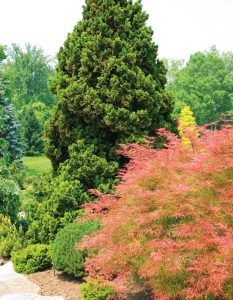 Hinoki false cypress (Chamaecyparis obtusa), an indispensable, low-maintenance conifer, has dark-green, scale-like leaves with white markings underneath. This native to Japan has cultivars available from trough- and rock-garden treasures that grow 1/4 inch a year to accent plants for use in mixed borders to large landscape trees. It grows in full sun to part-shade in average, well-drained soil and is disease-free.
Hinoki false cypress (Chamaecyparis obtusa), an indispensable, low-maintenance conifer, has dark-green, scale-like leaves with white markings underneath. This native to Japan has cultivars available from trough- and rock-garden treasures that grow 1/4 inch a year to accent plants for use in mixed borders to large landscape trees. It grows in full sun to part-shade in average, well-drained soil and is disease-free.
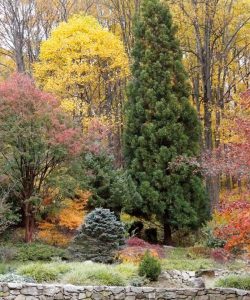 Japanese cedar (Cryptomeria) is valuable in our designed landscapes because of its graceful habit and beautiful disease-free foliage. There are many cultivars. A choice landscape-sized selection is ‘Yoshino’, which stays green year-round (avoid the regular form, which turns bronze in winter and often has patches of dead foliage). Cryptomeria tolerates part-shade and makes a good substitute for our ailing native hemlocks that should no longer be planted. ‘Globosa nana’ is a rounded shrub-sized form.
Japanese cedar (Cryptomeria) is valuable in our designed landscapes because of its graceful habit and beautiful disease-free foliage. There are many cultivars. A choice landscape-sized selection is ‘Yoshino’, which stays green year-round (avoid the regular form, which turns bronze in winter and often has patches of dead foliage). Cryptomeria tolerates part-shade and makes a good substitute for our ailing native hemlocks that should no longer be planted. ‘Globosa nana’ is a rounded shrub-sized form.
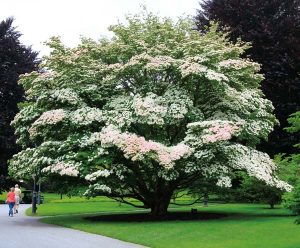 Kousa dogwood (Cornus kousa) is widely planted in Lancaster County for good reason. The foliage of this Asian native is not subject to the foliar disease (anthracnose) so common on our native dogwood (Cornus florida). The Kousa blooms in late spring after the leaves appear with large white to pinkish flowers (bracts) that mature into edible berry-like fruits that birds relish. In fall it displays great reddish-purple to scarlet color, and with maturity it has exfoliating tan and gray bark. This four-season tree grows 15-30 feet tall and is stunning.
Kousa dogwood (Cornus kousa) is widely planted in Lancaster County for good reason. The foliage of this Asian native is not subject to the foliar disease (anthracnose) so common on our native dogwood (Cornus florida). The Kousa blooms in late spring after the leaves appear with large white to pinkish flowers (bracts) that mature into edible berry-like fruits that birds relish. In fall it displays great reddish-purple to scarlet color, and with maturity it has exfoliating tan and gray bark. This four-season tree grows 15-30 feet tall and is stunning.
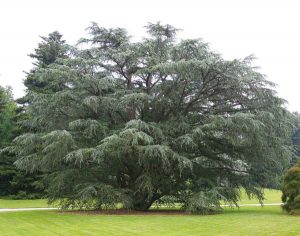 Blue Atlas Cedar (Cedrus) is a “true” cedar. There are numerous dwarf cultivars available, but it is usually valued as a landscape-sized conifer that matures at 40 feet in full sun. It has a loose habit when young and is often planted too close to structures (at maturity it is flat-topped with long spreading branches). The beautiful egg-shaped cones are borne upright on the stems over the green to silver-blue foliage. This conifer will continue to do well in future, increasingly hot decades because it is native to the mountains of northern Africa.
Blue Atlas Cedar (Cedrus) is a “true” cedar. There are numerous dwarf cultivars available, but it is usually valued as a landscape-sized conifer that matures at 40 feet in full sun. It has a loose habit when young and is often planted too close to structures (at maturity it is flat-topped with long spreading branches). The beautiful egg-shaped cones are borne upright on the stems over the green to silver-blue foliage. This conifer will continue to do well in future, increasingly hot decades because it is native to the mountains of northern Africa.
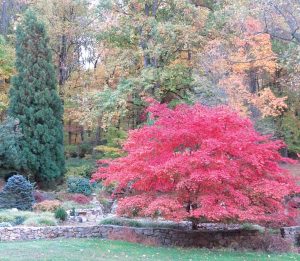 And what would our gardens be like without Japanese maples in their many forms? My favorite is the Full moon maple (Acer japonicum “Aconitifolium”). It is an easily grown and ideal patio tree that grows to 10 feet high with an equal spread. The stunning, deeply divided leaves are rounded, 6 inches across, and fern-like. In the autumn, the leaves blaze with the most saturated red color imaginable.
And what would our gardens be like without Japanese maples in their many forms? My favorite is the Full moon maple (Acer japonicum “Aconitifolium”). It is an easily grown and ideal patio tree that grows to 10 feet high with an equal spread. The stunning, deeply divided leaves are rounded, 6 inches across, and fern-like. In the autumn, the leaves blaze with the most saturated red color imaginable.





SHARE
PRINT